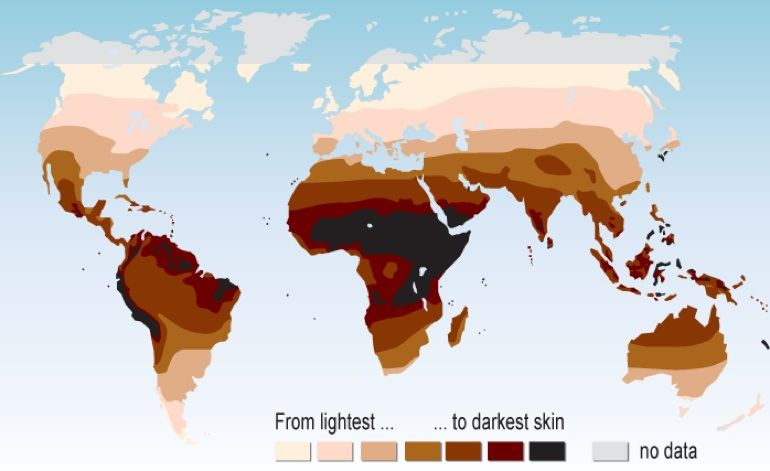More languages
More actions


Race is a social construct which influences how people are treated and viewed by society based on their skin color, appearance, and other traits. Although the term is used as a generic word to describe perceived differences between members of society from varying ethnic backgrounds, it is a scientifically inaccurate category related to phenotypical differences which have minimal influence on human behavior.[1] Discrimination of people based on racial differences is called racism.
The concept of race has been used since the 16th century to justify the invasion and colonization of lands, the genocide and slavery of peoples and the brutality associated with capitalism, liberalism and primitive accumulation of capital. Karl Marx wrote that the racial divide was a major obstacle for the workers' movement and that, "Labour cannot emancipate itself in the white skin where in the black it is branded."[2]
History[edit | edit source]
The concept of race first began in Spain with the expulsion of Jews and Muslims from the Iberian Peninsula and allowed the Spanish monarchy to continue oppressing them even after some converted to Christianity. In the early 17th century, the English defined the Irish as racially inferior while colonizing northern Ireland.[3]
During the colonization of America, whiteness emerged as a form of class collaboration against indigenous peoples. The first use of "white" in an official document was in Virginia in 1691.[4] A labor movement of slaves and indentured servants emerged in the 17th century, but the labor movement largely excluded non-white workers, enslaved or not, by the 1830s.[5] Many white workers and peasants such as John Brown and Newton Knight soon turned against their ruling class.[6]
Around the time of the Civil War in the United States, most trade unions in the USA accepted Italians and Irish workers but rejected Chinese immigrants. The IWW became the first union to include workers regardless of race.[5]
Scientific validity[edit | edit source]
The general consensus among actual biologists is that any biological differences between different "races" are extremely minor. Edgar & Kunley (2009) found that "Race is not an accurate or productive way to describe human biological variation."[7] In fact, there is evidence to suggest that there is more genetic difference between people of the same "race" than those of different "races":
- Barbujani et al. (1997): Zones of discontinuity in human gene frequency distributions are present, but the local gradients are so small that they can be identified only by simultaneously studying many loci using complex statistical techniques. In addition, such regions of relatively sharp genetic change do not surround large clusters of populations, on a continental or nearly continental scale. On the contrary, they occur irregularly, within continents and even within single countries.[8]
- Fujimura et al. (2014): [I]f one wants to measure the meaningfulness of differences between groups with different geographic ancestries, one needs to use a “proportion of variation” approach. This approach compares genetic variation among individuals within groups to the genetic variation between these groups. Ironically, Edwards’s (2003) reported findings confirm Lewontin’s (1972).[9]
Defenders of "race" as a biological reality like to call the above information "Lewtonin's fallacy" and insist that it has disproven. However, the arguments against "Lewtonin's fallacy" have not actually proved the idea of "race" as biological:
- Marks (2010): Geographical correlations are far weaker hypotheses than genetically discrete races, and they obviously exist in the human species (whether studied somatically or genetically). What is unclear is what this has to do with "race" as that term has been used through much of the twentieth century the mere fact that we can find groups to be different and can reliably allot people to them is trivial. Again, the point of the theory of race was to discover large clusters of people that are principally homogeneous within, and heterogeneous between, contrasting groups. Lewontin's analysis shows that such groups do not exist in the human species, and Edwards's critique does not contradict that interpretation.[10]
References[edit | edit source]
- ↑ By Peter G. Prontzos (May 14, 2019). The Concept of “Race” Is a Lie.
- ↑ “In the United States of North America, every independent movement of the workers was paralysed so long as slavery disfigured a part of the Republic. Labour cannot emancipate itself in the white skin where in the black it is branded.”
Karl Marx (1867). Capital, vol. 1: 'The Working-Day'. [MIA] - ↑ Roxanne Dunbar-Ortiz (2014). An Indigenous Peoples' History of the United States: 'Culture of Conquest' (pp. 36–9). ReVisioning American History. [PDF] Boston: Beacon Press Books.
- ↑ Eugene Puryear (2022-07-10). "The U.S. state and the U.S. revolution" Liberation School. Archived from the original on 2023-06-04.
- ↑ 5.0 5.1 Bill Fletcher Jr. (2020-07-01). "Race Is About More Than Discrimination" Monthly Review. Archived from the original on 2023-03-23.
- ↑ Paul Wilcox (2020-09-07). "Abolitionist solidarity — Black and white — in the struggle against slavery" Liberation School. Archived from the original on 2023-06-10.
- ↑ H. J. H. Edgar & K. L. Hunley (2009), "Race reconciled?: How biological anthropologists view human variation," American Journal of Physical Anthropology, 139(1), 1–4, http://dx.doi.org/10.1002/ajpa.20995.
- ↑ Guido Barbujani et al. (1997), "An apportionment of human DNA diversity," PNAS, 94(9), 4516-4519, https://doi.org/10.1073/pnas.94.9.4516.
- ↑ J. H. Fujimura et al. (2014), "Clines Without Classes: How to Make Sense of Human Variation," Sociological Theory, 32(3), 208-227, https://doi.org/10.1177/0735275114551611.
- ↑ Jonathan Marks (2010), “Ten Facts about Human Variation,” in Human Evolutionary Biology, edited by Michael P. Muehlenbein (Cambridge: Cambridge University Press), 265–76, https://doi.org/10.1017/CBO9780511781193.019.
